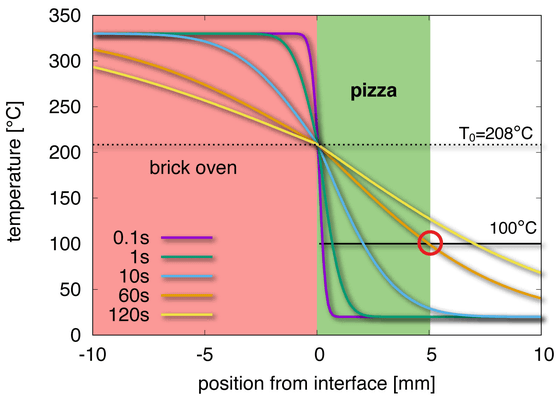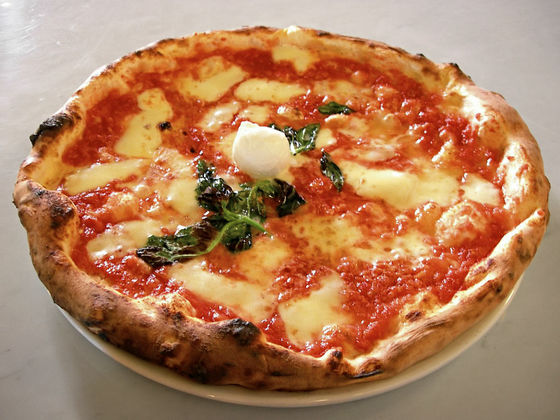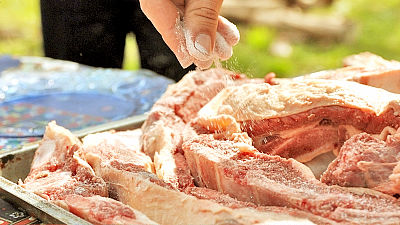A thesis on thermodynamically analyzing 'best way to bake pizza' is being published

The law of physics is sleeping at the root of every cooking law .... That means that "When making a pizza, what kind of difference will be made between a traditional brick pizza kiln and the electric oven today?" The mechanically analyzed paper is uploaded to the paper submission site arXiv .
The Physics of baking good Pizza
https://arxiv.org/abs/1806.08790
It is a way of conveying heat that you can not miss on analyzing the difference between old-fashioned pizza kiln and the electric oven at this time. As an example, consider a scene where a mother places his forehead on a child who gave a fever.
The figure below shows a chart showing the state of heat when a mother places his forehead on her child. The horizontal axis represents the distance from the face where the child and mother are in contact with, the boundary surface where the vertical line at the middle 0 position is in contact, the red left side is the child's forehead, the blue right side is the mother's It has become ok. The vertical axis is temperature, 37 ° C (T 0) is 37 ° C (T 0) for the child's forehead at 38 ° C and the boundary line where the 36 ° C mother's forehead is attached. The purple line that shows the temperature distribution after 0.1 second after joining the forehead is almost vertical at the part where the forest is attached, and it is clearly shown that the body temperature is clearly different between the child and the mother. On the other hand, the yellow line representing 60 seconds is gentle, the child's forehead is gradually chilled, and on the contrary the mother's forehead is gradually warming up.

Assuming that the mother's forehead is made of iron, the graph looks like the following. This time the temperature at the point where the forehead is attached drops to 36.3 ° C. This is because the heat conductivity of iron is high and it is possible to efficiently extract heat from the forehead of the child.

Heat capacity is the amount of heat required to raise 1 ° C unit by 1 ° C. In SI unit system, it is written as J / kg · K. Heat capacity is expressed by the following equation. c is the heat capacity, Q is the heat quantity, M is the mass of the object, and T is the temperature. Δ is a symbol representing the amount of change and means the amount of Q to change T by 1 unit with ΔQ / ΔT.

Also, the following formula expresses the exchange of heat. S represents area, and t represents time.

When heat is exchanged between two things, the amount of heat per unit time / unit area of the exchange is called a heat flux (q), expressed in units of W / m 2. The ρ that appears in the calculation of M represents the mass density .

In addition, the ease of heat transfer due to thermal conduction is called thermal conductivity and is expressed in units of W / mK. In this example, this thermal conductivity is expressed by the letter κ. From this equation of heat conduction, we can calculate the temperature (T 0) of the boundary when the temperature is transferred from the object of temperature T 1 to the object of T 2 as follows.

Ν 21 appearing in the above equation is expressed by the following formula and is used to obtain the temperature of the boundary when the temperature is transferred from the substance of "1" to the substance of "2". Here, χ represents the temperature diffusivity .

The table below shows the heat capacity, thermal conductivity, mass density, temperature diffusivity, and ν21 of pizza dough and iron, brick and water respectively. For ν21, pizza dough, iron, brick "2" is pizza dough, water is "1" as iron.

Based on this table, I will consider the temperature when baking pizza. When putting 20 ℃ pizza dough into a 330 ℃ brick kiln, the temperature of the contact point between the brick kiln and the pizza dough will be about 208 ℃. Also, if the pizza thickness is 5 mm, the surface will exceed 100 ° C after 60 seconds from placement.

If I try the same calculation in an electric oven whose surface is iron rather than brick, if the temperature of the electric oven is 330 ° C, the contact with pizza will be about 300 ° C. In this case, since the temperature is too high, it is said that the result of about 230 ℃ will be obtained when the back calculation of the electric oven to make the contact point of pizza and the electric oven at about 210 ℃. However, if it is set to 230 ° C, it will not be possible to realize cooking similar to that of a brick kiln even in an electric oven, but now we need to think about elements of thermal radiation . Heat radiation is indicated as "Radiation" in the photograph below, and it is expressed as the amount of heat reaching per square centimeter in the kiln.

In conclusion, in a brick kiln, 0.75 J / sec of heat per square centimeter of pizza is delivered as thermal radiation. On the other hand, in the electric oven it can deliver only 0.36 J / s per square centimeter of pizza with thermal radiation. It is necessary to reflect this difference well in the time to bake the pizza.
Also, care must be taken for the moisture contained in the pizza. For example, in the case of Margherita pizza where tomatoes and mozzarella cheese are topped, pizza consists of 240 g of dough and 90 g of topping. One-third of the dough and 80% of the topping are moisture, about 150 g of the whole is moisture. While the pizza is baked, about 30 g of this moisture absorbs heat and evaporates.
Calculating while taking these factors into consideration, the optimum baking time for pizza is 125 seconds for a brick kiln at 330 ° C and 170 seconds for an electric oven at 230 ° C. When the temperature of the brick kiln is raised to 390 ° C. and the temperature of the boundary between pizza and brick kiln is brought to 240 ° C., although the surface topping is slightly not burned, the baking time is 82 seconds and pizza production It increases the amount. A skillful pizza fryer seems to use a technique that uses pizza pear and warms only the surface without burning the dough well, while considering the moisture content of the topping.

At the end of the paper, the authors say, "Many people can not distinguish between the best pizza and the next pizza," while "traditional brick kilns are the ideal way to bake the perfect pizza" I said.
Related Posts:







